MSI Z97 Gaming 7 (LGA 1150) Motherboard Review
Ryan Martin / 11 years ago
Introduction, Specifications and Packaging
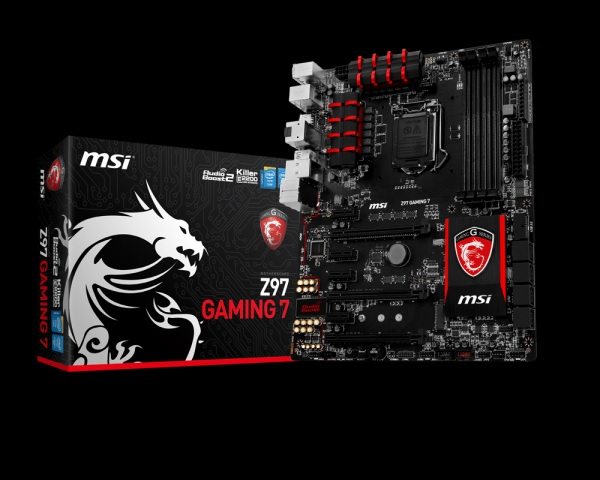
This beautiful looking creation from MSI is our second Z97 motherboard review for this launch day, in addition to the ASUS Z97-A we recently checked out. In contrast to the entry level ASUS Z97-A, the MSI Z97 Gaming 7 jumps straight to the other end of the spectrum and this is a really high end creation aimed specifically at meeting the needs of modern gamers. The MSI Z97 Gaming 7 has all the trademark styling of the MSI Gaming Series as well as the trademark features of a gaming motherboard: a dedicated high performance Gigabit NIC, a custom audio implementation and adequate room for plenty of GPUs to maximise those frame rates. The MSI Z97 Gaming 7 motherboard has a boatload of features: a 12 phase VRM, 8 SATA III ports, support for up to 3 way CrossFire, advanced ALC 1150 Realtek audio and a Killer E2205 Gigabit NIC. Those features mean this motherboard is sure to appeal to a large audience in the same way MSI’s Gaming Series graphics cards have done. With all that said you might expect the MSI Z97 Gaming 7 to be a pricey option, but at just $190 or £140 this is probably the cheapest flagship gaming motherboard I’ve ever seen…so let’s see what it has to offer!
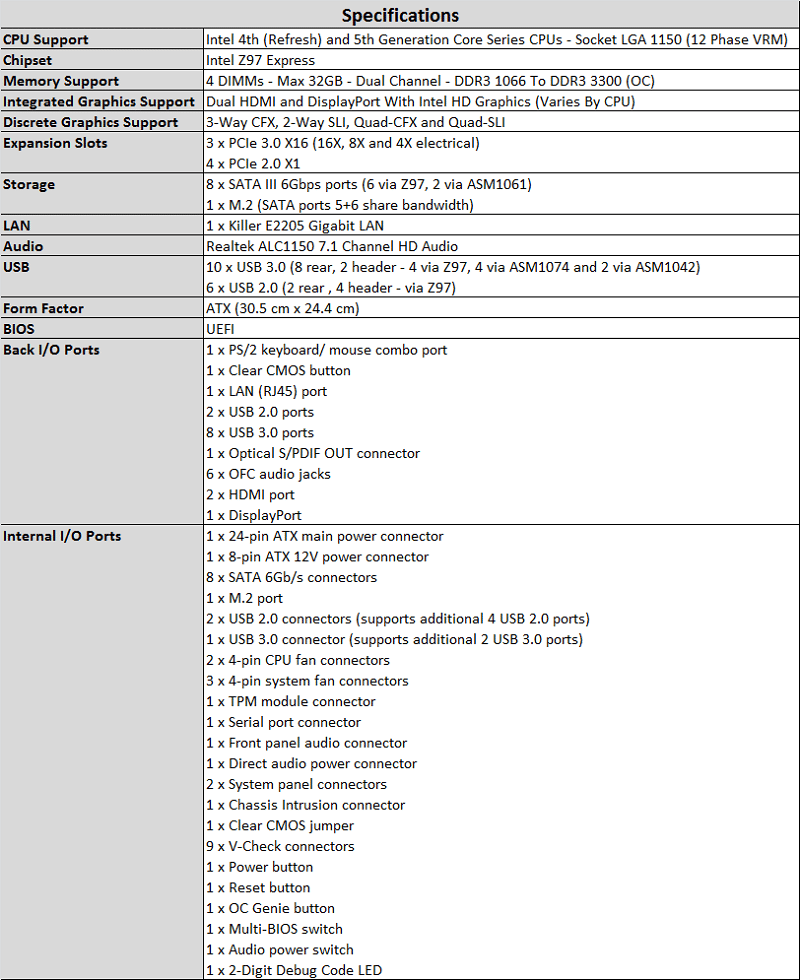
Packaging and Accessories
As expected the packaging continues to the MSI Gaming Series theme, the two standout features are of course the Killer E2200 NIC and the up-market audio implementation.
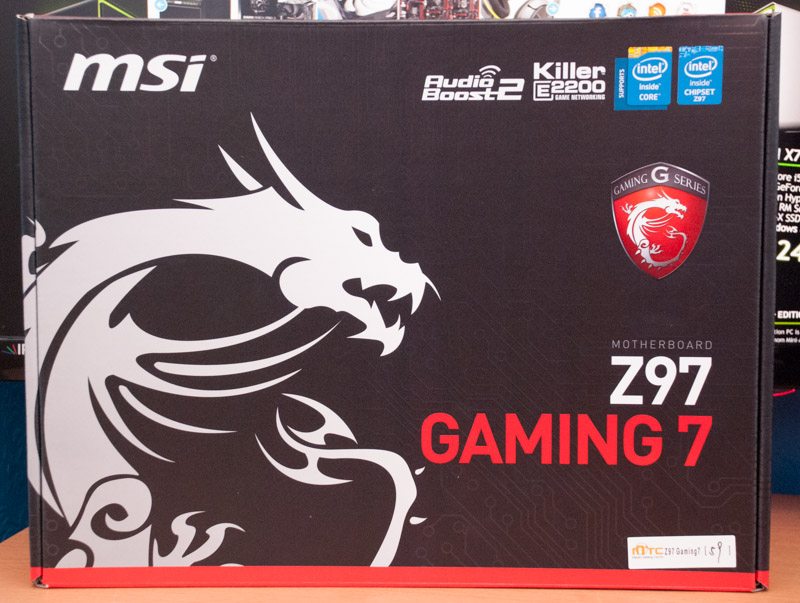
The back of the box gives us a closer look at the features of this motherboard but we invite you to check out the product page if you’re interested in reading more.
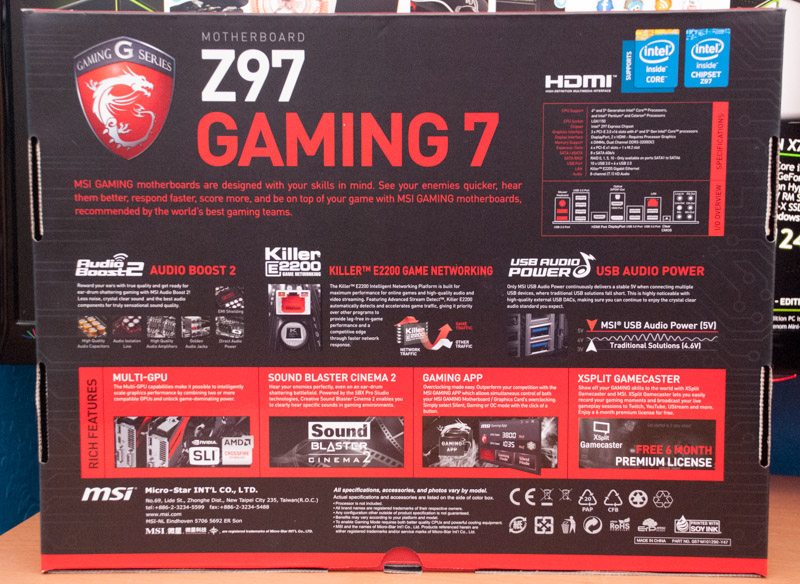
The bundle is fairly dense with a user manual, software and application guide, overclocking guide, driver and utility DVD, cable labels and a door hanger.
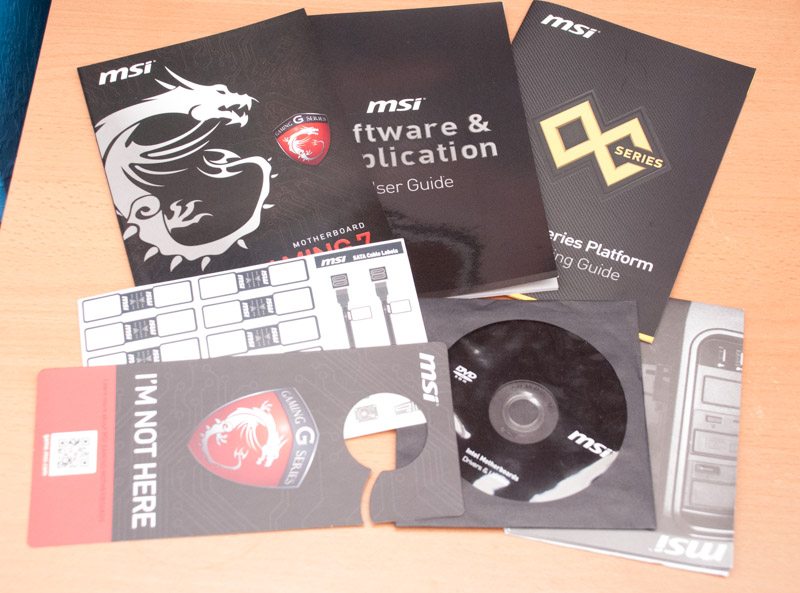
Furthermore, we get some MSI MConnectors for hooking up your front panel connectors, a padded and styled rear I/O shield, an MSI case badge/sticker, four SATA III cables, an SLI bridge, a power adapter (to convert molex into the audio power input) and voltage checkpoint cables.
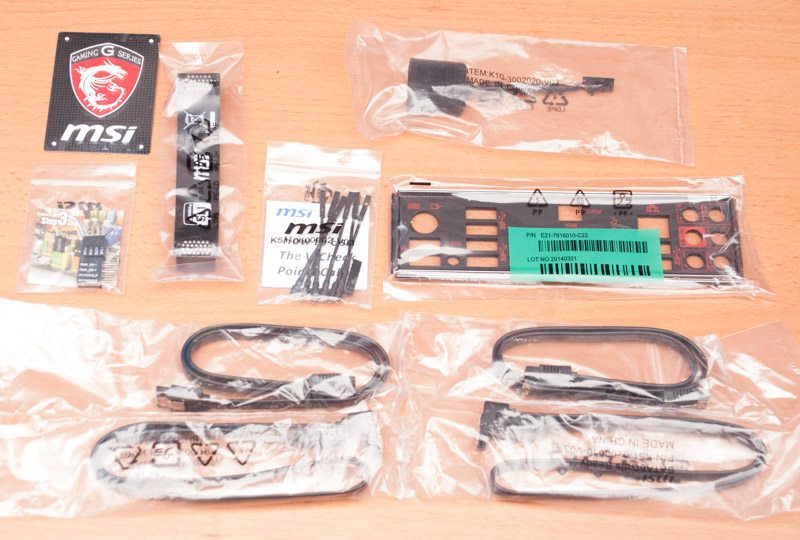
A Closer Look & Layout Analysis
With the perennial classic red & black theme and a beautiful matte black PCB the MSI Z97 Gaming 7 is built to seduce. For the price point the MSI Z97 Gaming 7 offers up an impressive gamer aesthetic that can rival the ASUS ROG line for substantially less. MSI have done a great job with the layout of this motherboard: they have the 8 + 24 pin power connectors in the ideal locations and the SATA III and USB 3.0 ports neatly clustered together and right angled for better cable management. My only concern about the layout is why the second CPU fan header is so far away from the first on the opposite side of the memory lanes. That aside I am thoroughly impressed with the layout and aesthetics of this motherboard. I’m also pleased to see SATA Express has been ditched in favour of extra SATA ports. Not that I am anti-new technology but I just find SATA Express redundant – why waste two SATA 6G ports to get 10G, AND require an additional connector AND a custom cable – did people forget about RAID? From a gamer standpoint MSI have been sensible to ditch SATA Express.
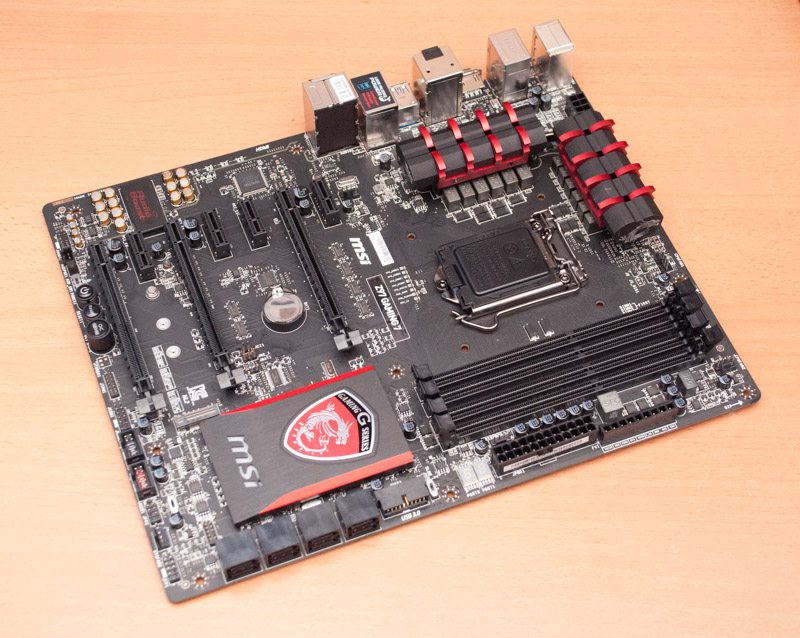
Around the CPU socket we find an impressive 12 phase VRM using MSI’s Super Ferrite Chokes (SFCs).
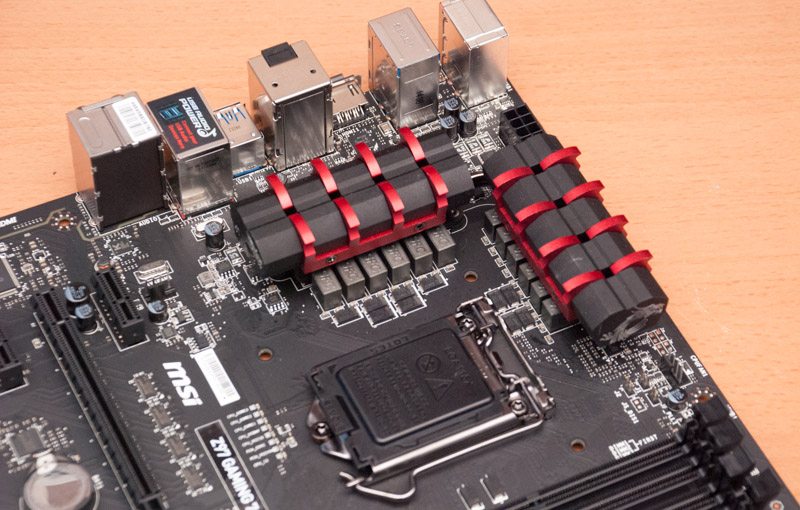
Along the side of the motherboard we get a debug LED and voltage read off points. These are certainly surprising additions although being a gaming motherboard you can’t help but wonder what function VCheck points serve…I am a reviewer and I don’t find a use for them so why on earth would a gamer need them?
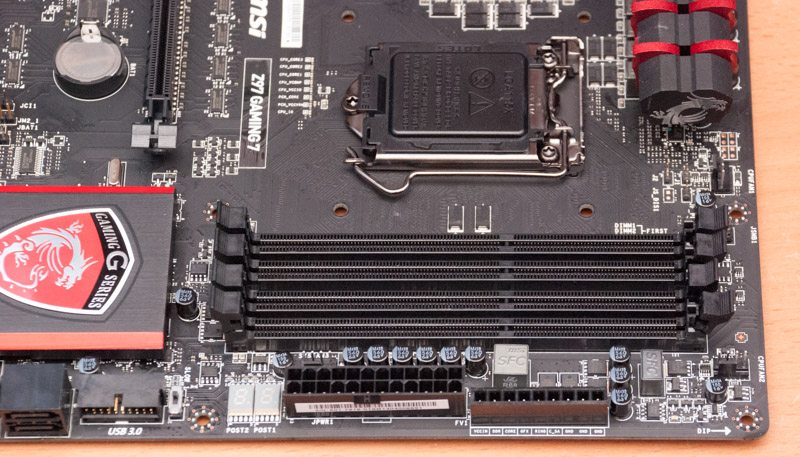
In terms of storage connectivity there are 8 SATA III ports, ports 0-6 (starting on the right) are run through the Z97 chipset while ports 7-8 are provided by the ASMedia controller.
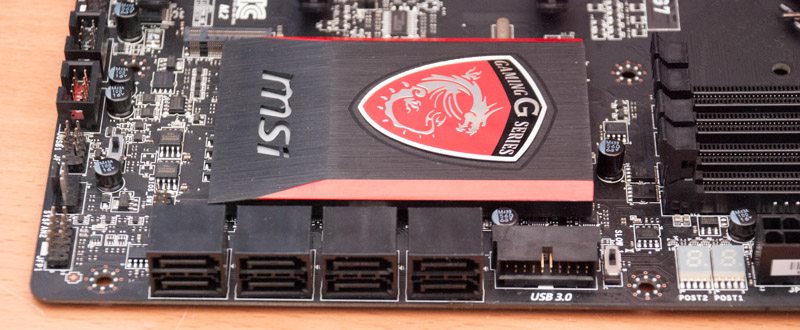
Along the bottom we find MSI’s famous OC Genie button as well as a power and reset switch. There’s also a dip switch to choose between two different amplifiers in your audio depending on the impedance of your headphones.
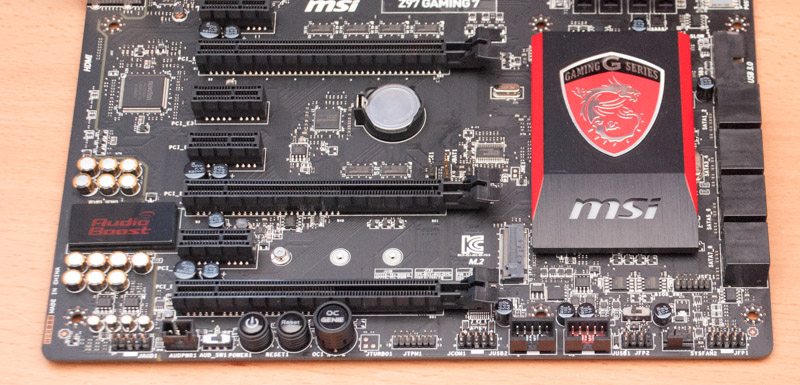
Looking closer at that audio area we can see the separated PCB, nichicon audio capacitors, dual headphone amplifiers and the EMI shielding over the ALC 1150 codec.
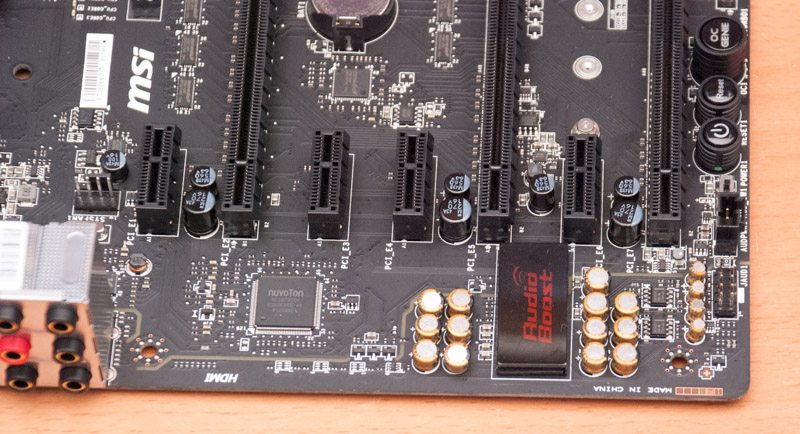
Interestingly the heatsinks are connected by a 6mm nickel-plated copper heat pipe which should allow for better VRM cooling.
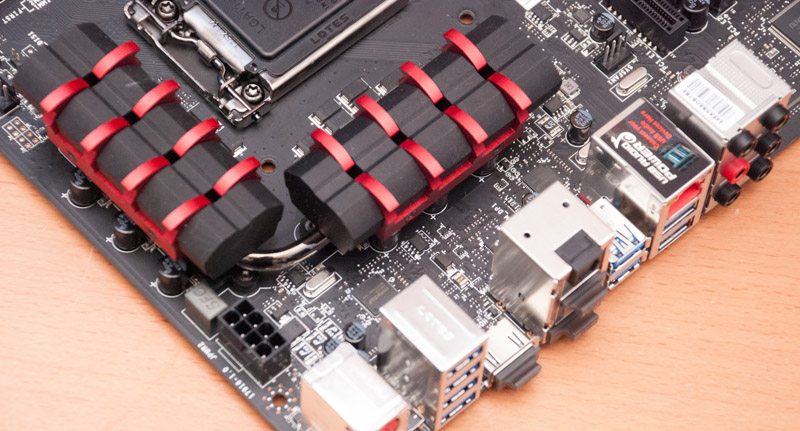
The rear I/O has an impressive amount of USB connectivity as well as gold plated audio jacks. The red block of connections at the end are the “Gaming Device Ports” which have more optimised tracers for lower latency in addition to more gold content for higher durability.

Flipping the motherboard over and we can see that all the heatsinks are easily removable with a screw driver. We also get a closer look at the matte black PCB and audio PCB separation.
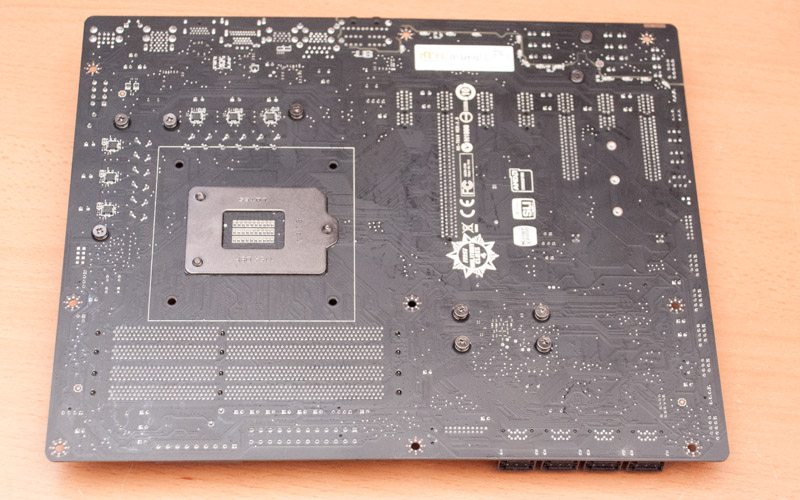
The Test System and Test Software
Before we delve into any testing we would like to take this opportunity to review our test system and thank those sponsors who kindly provided us with test equipment to make our work possible. We offer our thanks to:
Intel for supplying us with a Core i7 4770K processor, which we reviewed here.
Kingston for supplying us with a Hyper X 3K 240GB solid state drive, which we reviewed here, and the Hyper X USB 3.0 DTHX Flash Drive, which we reviewed here.
Corsair for supplying us with a Hydro Series H100i liquid CPU cooler, which we reviewed here, and a Vengeance Pro 16GB 2400MHz memory kit, which we reviewed here.
Be Quiet for supplying us with a Straight Power E9 680W power supply unit, which we reviewed here.
Plextor for supplying us with a 256GB M.2 solid state drive, which we reviewed here.
Sapphire for supplying us with an AMD R9 290 Tri-X graphics card, which we reviewed here.
ASUS for supplying us with an RT-AC68U wireless AC gigabit router, which we reviewed here.
Patriot for supplying us with a Wildfire 120GB solid state drive, which we reviewed here.
Lian Li for supplying us with a PC-T60A test bench.
Noctua for supplying us with NT-H1 thermal compound.
Rosewill for supplying us with an Infrared thermometer.
Test System
- Motherboard: varies by review
- CPU: Intel Core i7 4770K processor
- GPU: Sapphire R9 290 Tri-X graphics card
- RAM: Corsair Vengeance Pro 16GB 2400MHz kit (CL11, 2 x 8GB)
- Cooling: Corsair H100i with Noctua NT-H1 Thermal Compound
- Case: Lian Li PC-T60A test bench
- Storage Drives: Kingston 240GB Hyper X 3K SSD, Patriot 120GB Wildfire SSD, Kingston Hyper X 64GB USB 3.0 flash drive and Plextor 256GB M6e M.2 SSD
- PSU: Be Quiet Straight Power E9 680W
- Operating System: Windows 7 Ultimate 64 Bit SP1
- Networking: ASUS RT-AC68U router
Test Software
- SiSoft Sandra Engineer – available here.
- WPrime – available here.
- Cinebench – available here.
- 3DMark – available here.
- Bioshock Infinite – available here.
- Tomb Raider – available here.
- AIDA 64 Engineer – available here.
- DPC Latency Analyser – available here.
- Rightmark Audio Analyser – available here.
- LAN Speed Test Lite – available here.
- Passmark – available here.
BIOS
MSI’s Click BIOS 4 is fairly similar to what we saw on their Z87 motherboards. As far as I can tell this is more or less identical to the MSI Z87I Gaming AC motherboard we reviewed not that long ago bar a few minor tweaks and optimisations. It appears the fan control system has become visually more attractive and slightly more advanced in terms of its functionality. Other than that I’m struggling to see many differences to the last generation of Gaming boards. However, that isn’t a bad thing because this is still a great BIOS, my only quibble last time around was the “low resolution” of 1024 x 768 compared to the full HD of other vendor BIOSes and nothing has changed in that regard. Although if you consider how little time is spent in the BIOS this is hardly a significant issue. MSI’s Click BIOS 4 is a fairly strong UEFI implementation although in my opinion I would like the layout to be a bit more intuitive: having most of the screen taken up by the Gaming Series branding emblem is a waste of productive space.
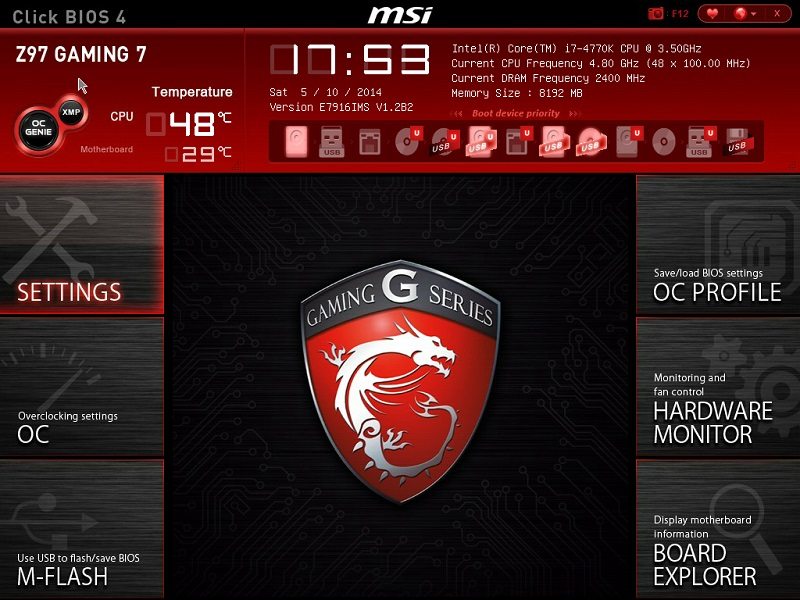
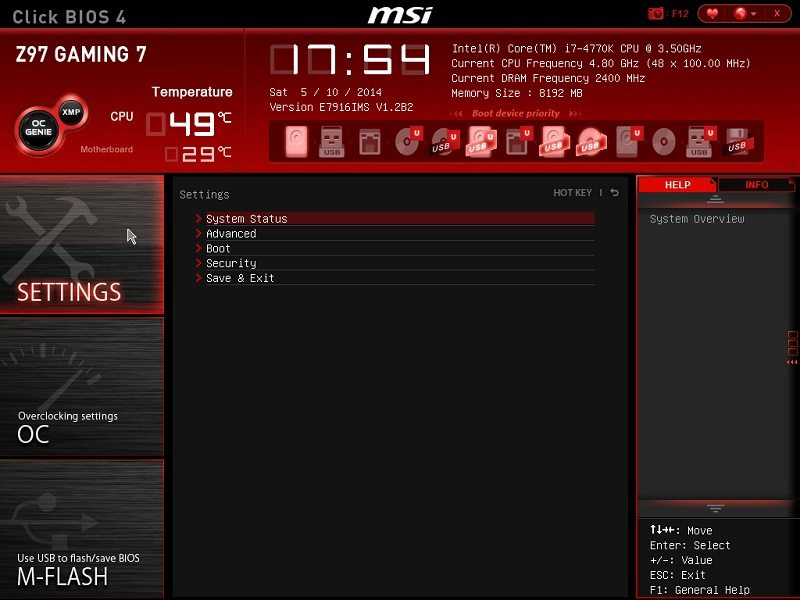
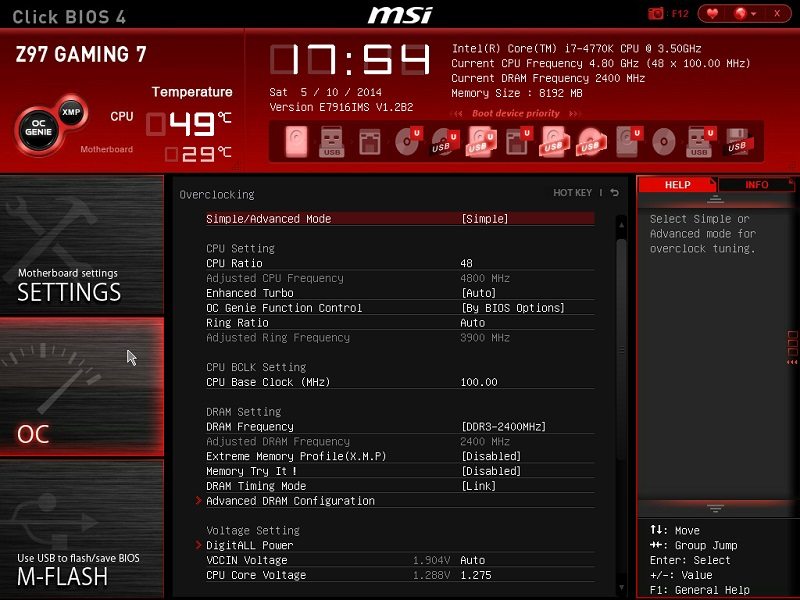
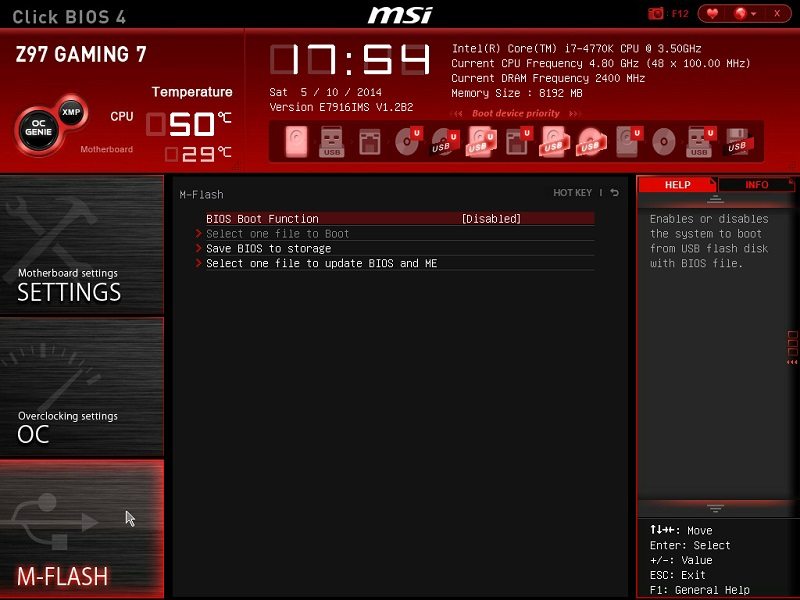
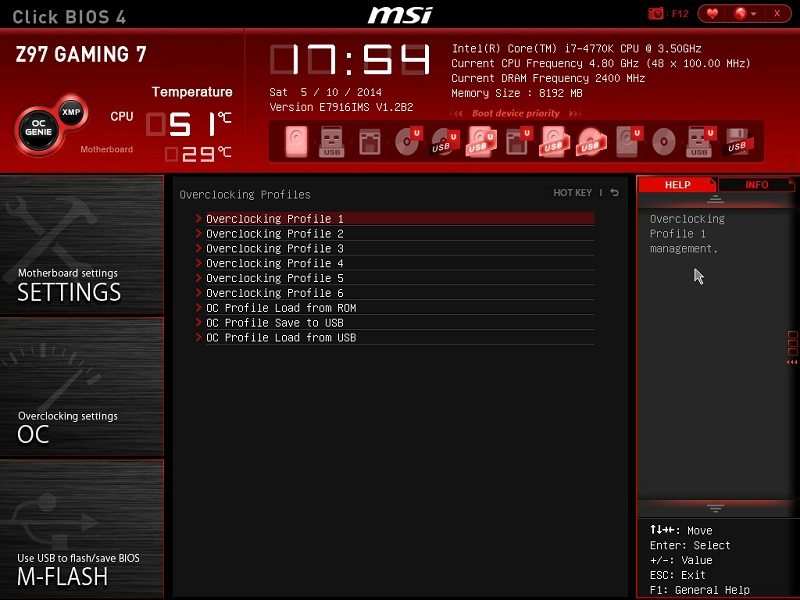
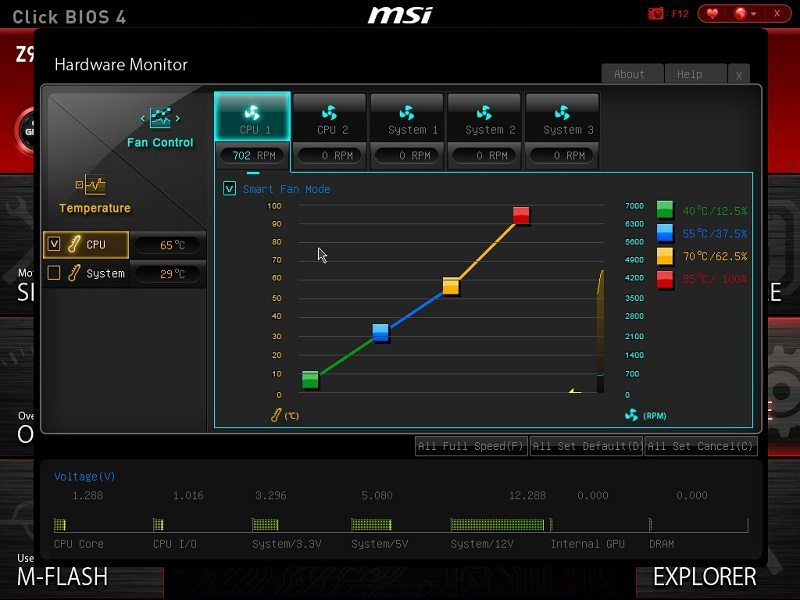
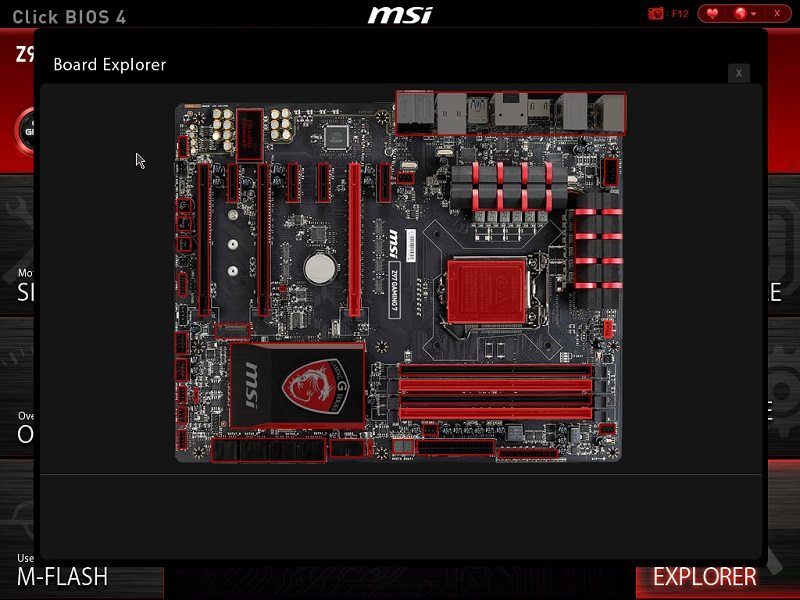
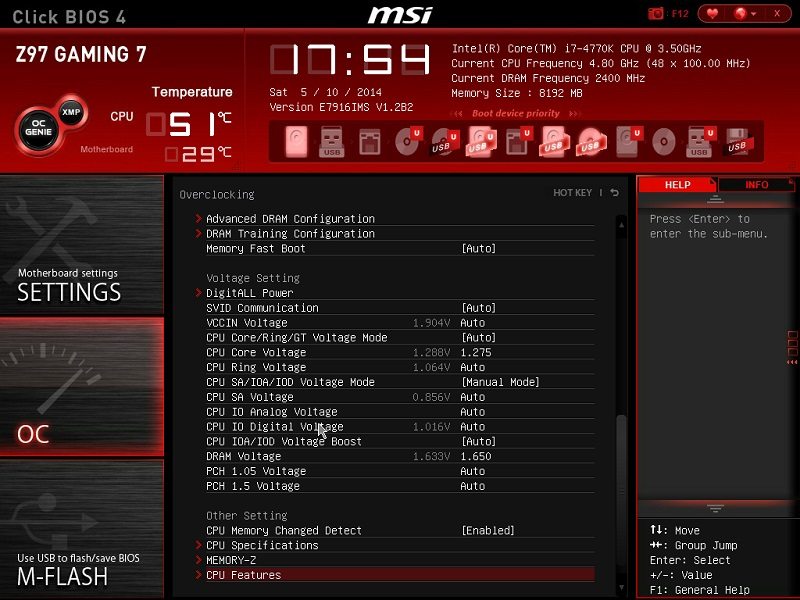
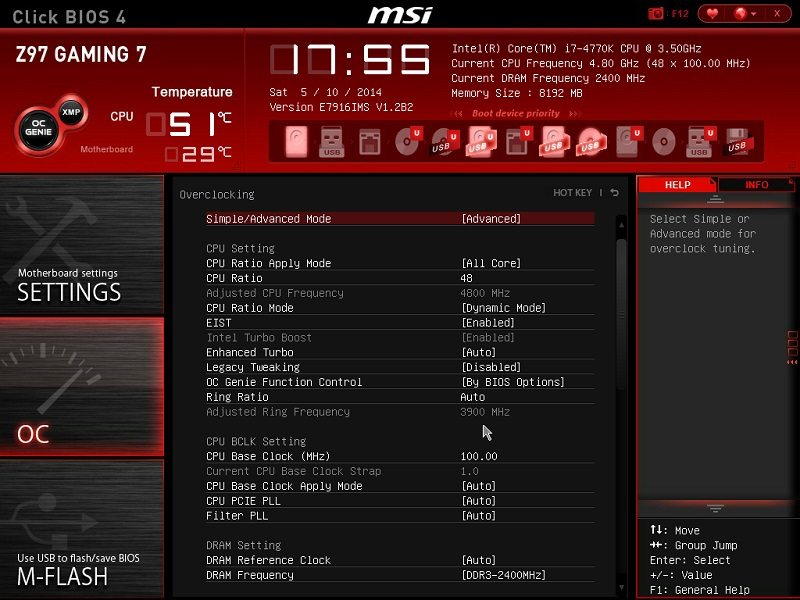
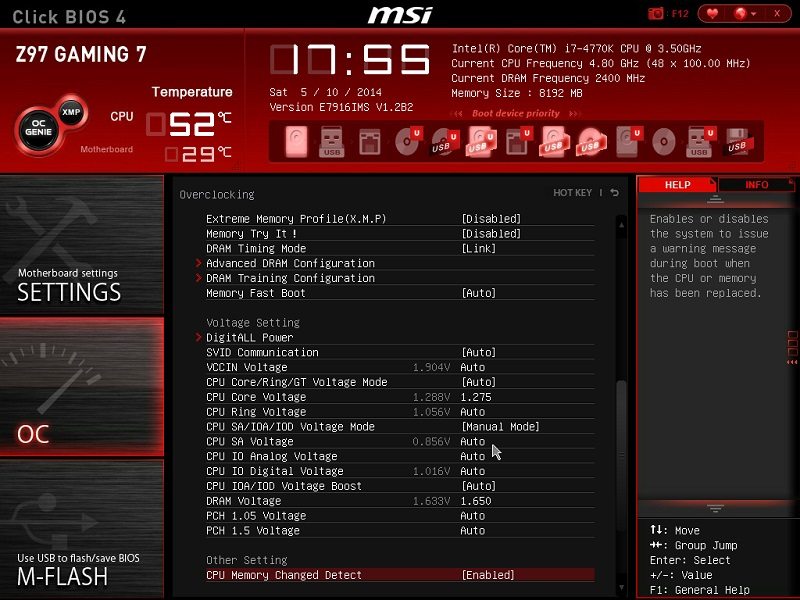
Software Overview
In terms of the software bundle there are a few mainstays we will bring your attention to briefly. MSI’s Super Charger is still present along with the latest version of Live Update that helps to keep your programs and drivers on the latest versions. MSI’s handy Go2BIOS feature is still available and I am a really big fan of this, it allows you to go to the BIOS without needing to physically interact with a button on the board.
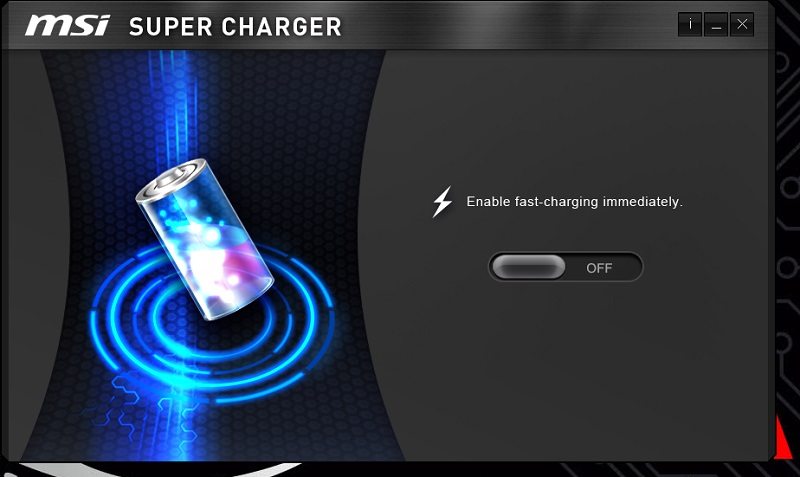
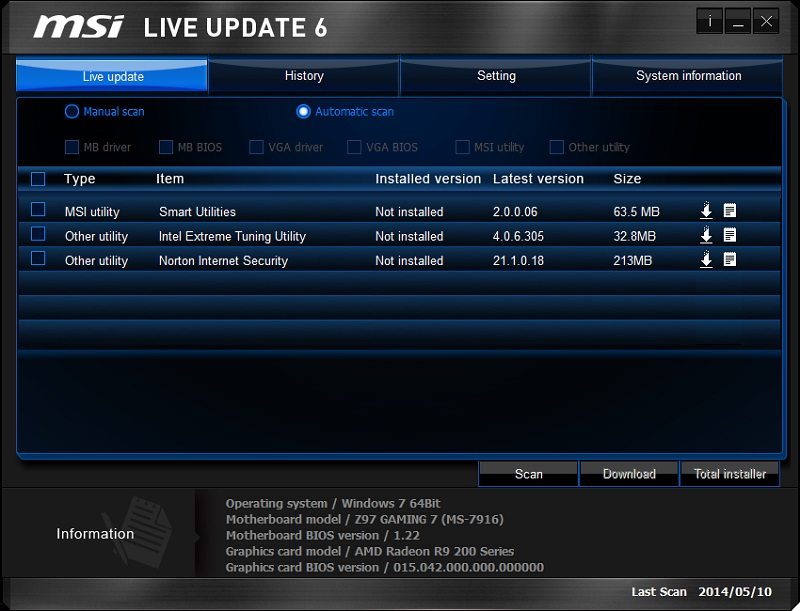
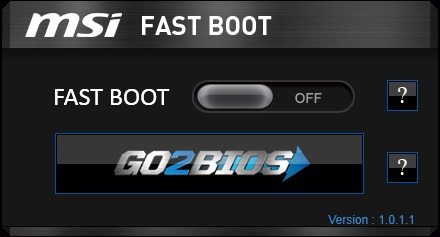
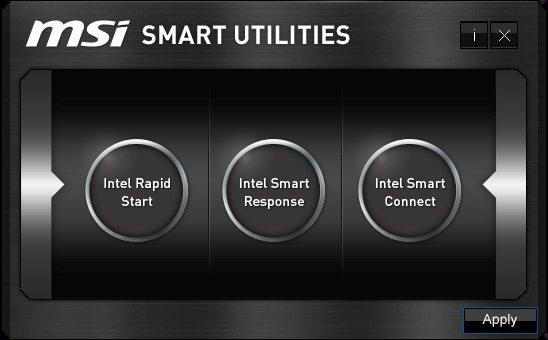
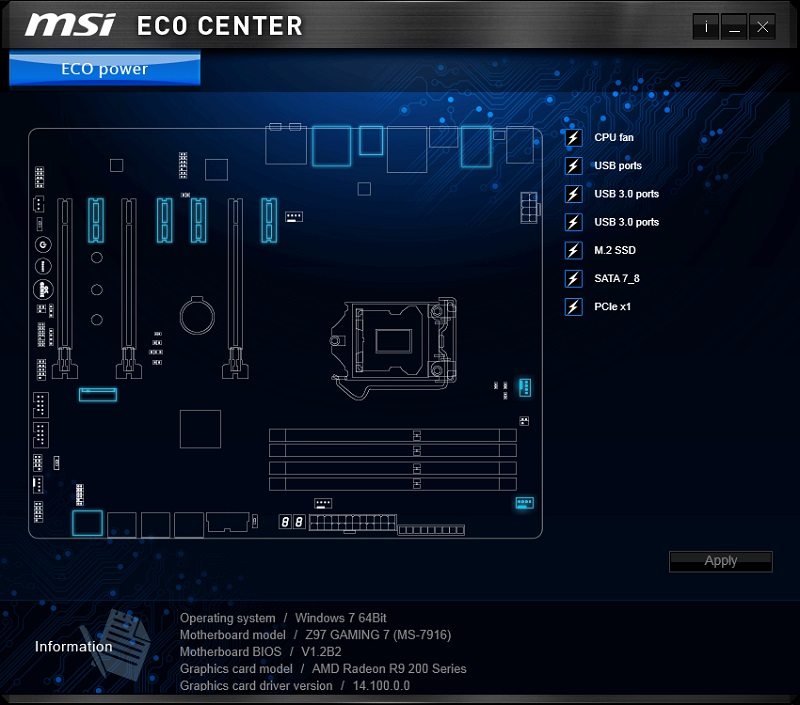
Moving onto what’s new and we have the revamped Command Centre. One of the interesting companions is the MSI Gaming App which essentially allows you to activate overclock profiles optimised for Gaming on the fly. This little widget box slots onto your desktop quite discretely.
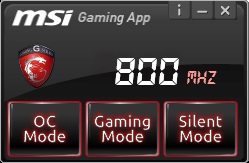
Moving into the Command Centre and we see a few of the main tabs. The MSI RAMDisk continues to catch my eye because I’m unaware of any other motherboard vendor offering a free RAMDisk to its customers. I’m personally surprised that MSI don’t make a bigger deal out of it, it is a really nifty feature. The rest of the command centre is generally a very nice piece of software allowing you incredibly detailed control over frequencies, voltages and timings of all your various components.
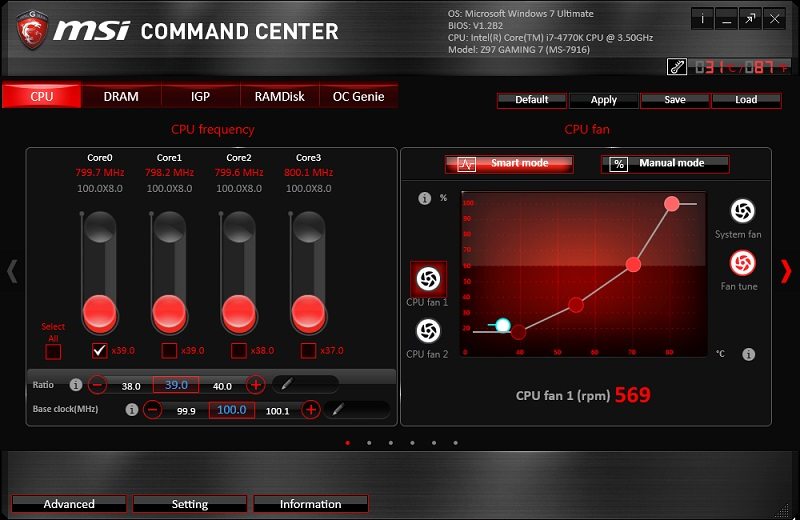
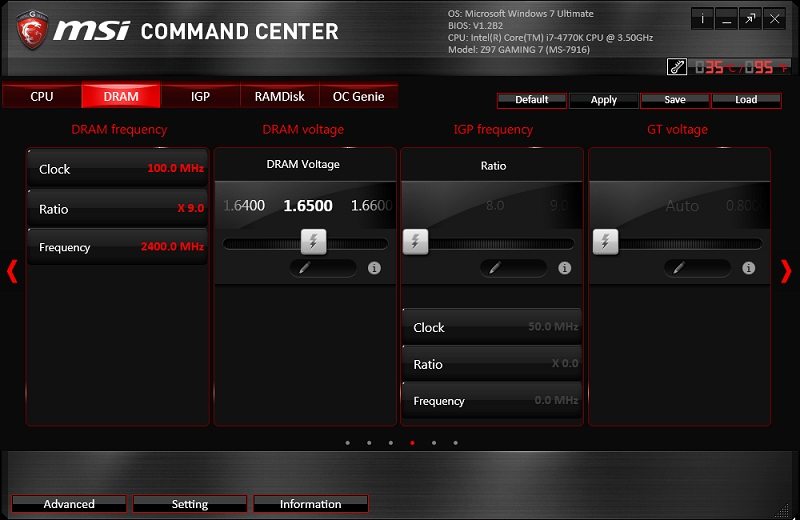
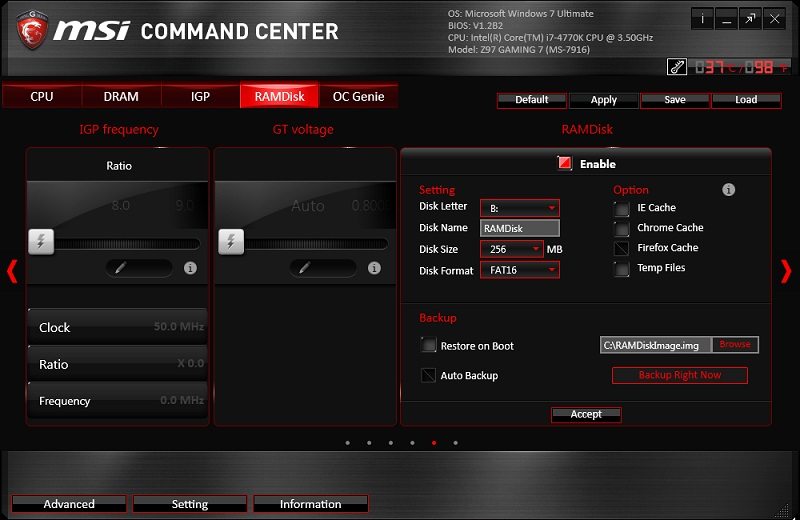
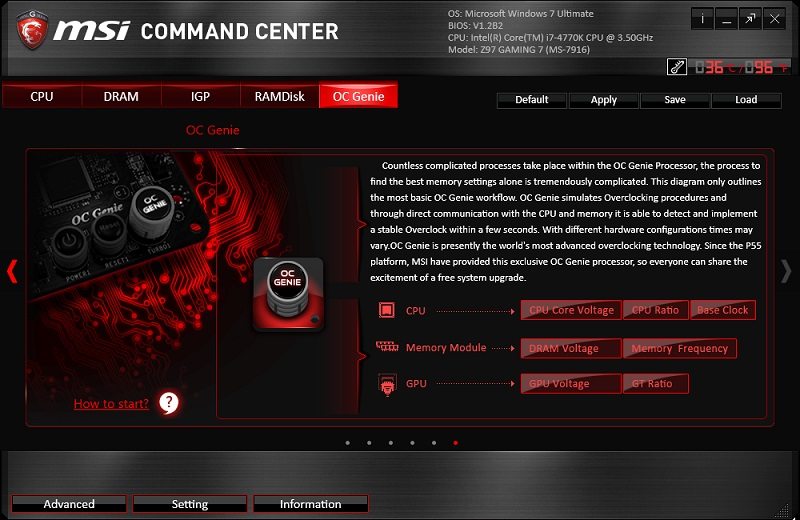
For the overclockers MSI offer an advanced voltage tweaking tab which is probably aided by the voltage checkpoints if that interests you.
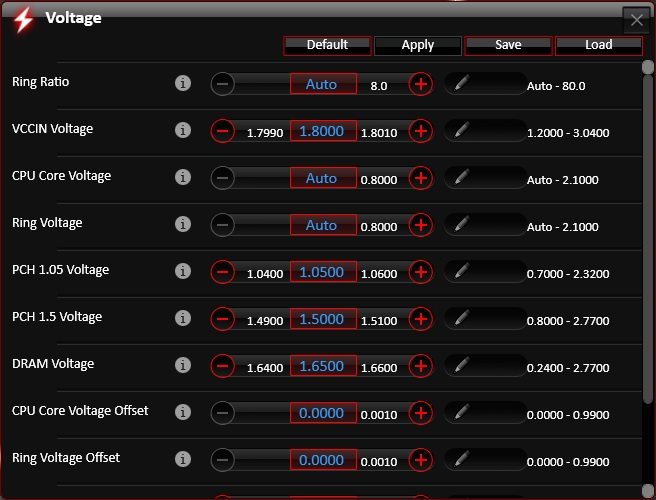
MSI have their own fan tuning utility for anyone looking for increased control over their system’s cooling.
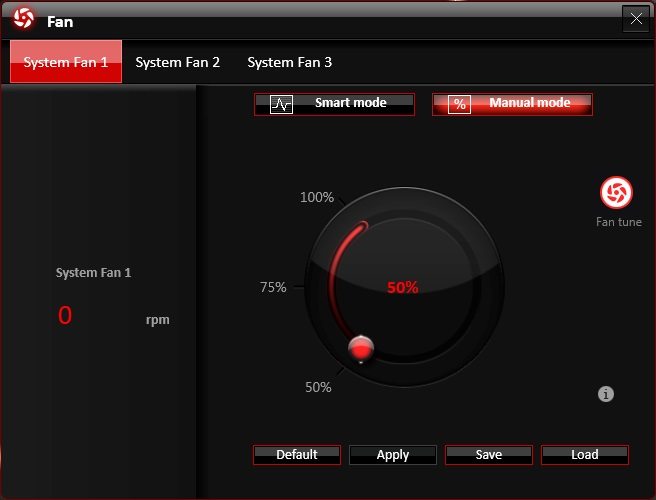
Another thing I thought was pretty cool is the fact MSI have their own mobile App to allow you to control aspects of your system from your mobile. However, the app does appear to have fairly lacklustre reviews on the Google Play Store from users so maybe it is about time MSI splatted some of their bugs.
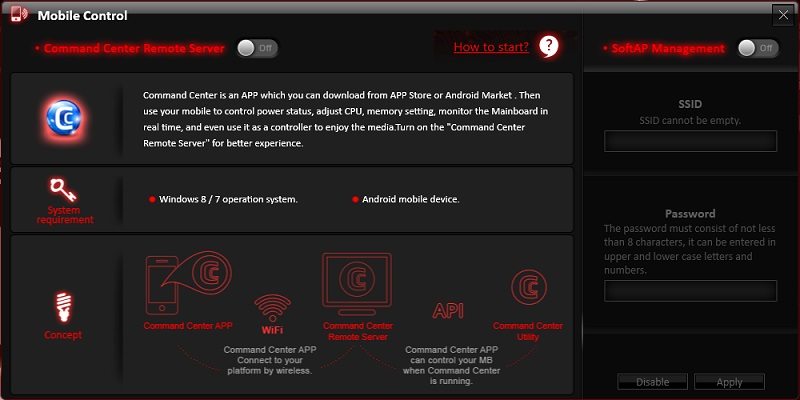
The final piece of software worth mentioning isn’t developed by MSI themselves but they are sponsoring it. XSplit Gamecaster is provided with this motherboard – you get an impressive 6 month premium license so if you’re into streaming your games to services like Twitch then this could be for you. We didn’t really have time to explore this program but if you want to find out more you can do so here.
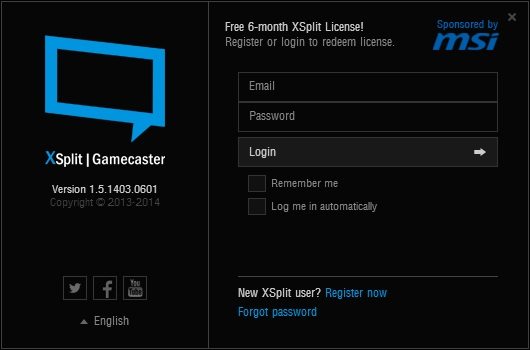
Overclocking
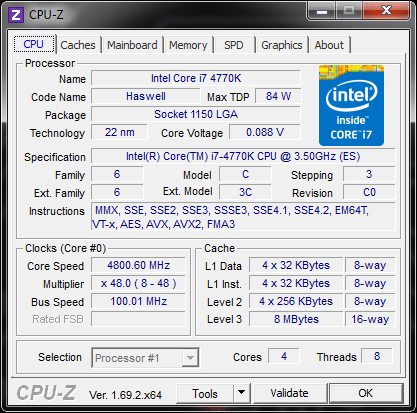
Overclocking went exactly to plan: we know our 4770K cannot do more than 4.8GHz without overheating from the additional volts required to get to 4.9GHz and unsurprisingly we topped out at 4.8GHz on this motherboard. We needed around 1.275 volts to achieve 4.8GHz which is a strong showing from this motherboard and we can see the 12 phase VRM doing its job. In reality the 12 phase VRM is massive overkill for Haswell CPUs because the VRM is controlled on-die but nonetheless it is great to have such a powerful overclocking motherboard. Maybe we will see the 12 phase VRM come into its own on Intel’s new Haswell Refresh K Series CPUs expected later this year.
CPU Performance
Cinebench
CINEBENCH is a real-world cross platform test suite that evaluates your computer’s CPU performance. Cinebench R15 is a totally free utility and is available for download here.
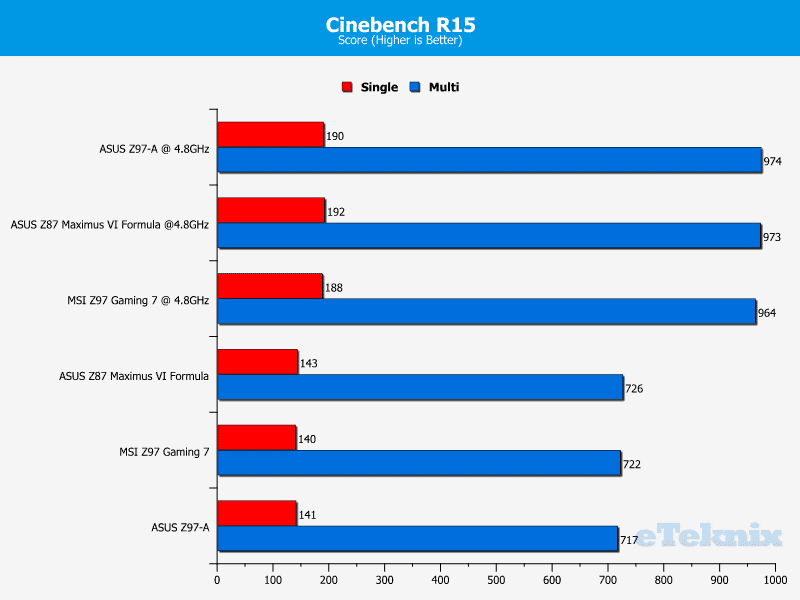
WPrime
wPrime is a leading multithreaded benchmark for x86 processors that tests your processor performance by calculating square roots with a recursive call of Newton’s method for estimating functions. wPrime is a free utility that is available for download here.
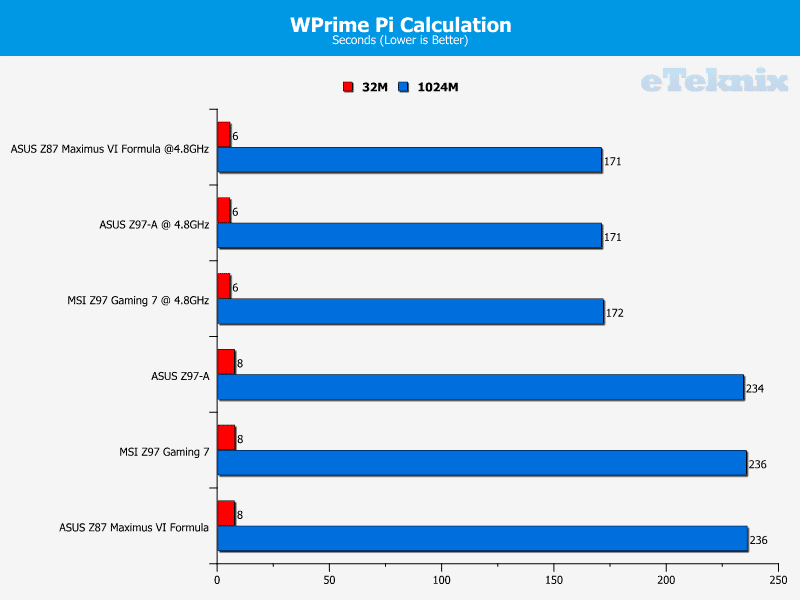
SiSoft Sandra
The SiSoft Sandra Dhrystone and Whetstone benchmarks are widely used measures of compute power and performance for a wide array of real world usage scenarios. You can find out more details on these tests here or download SiSoft Sandra here.
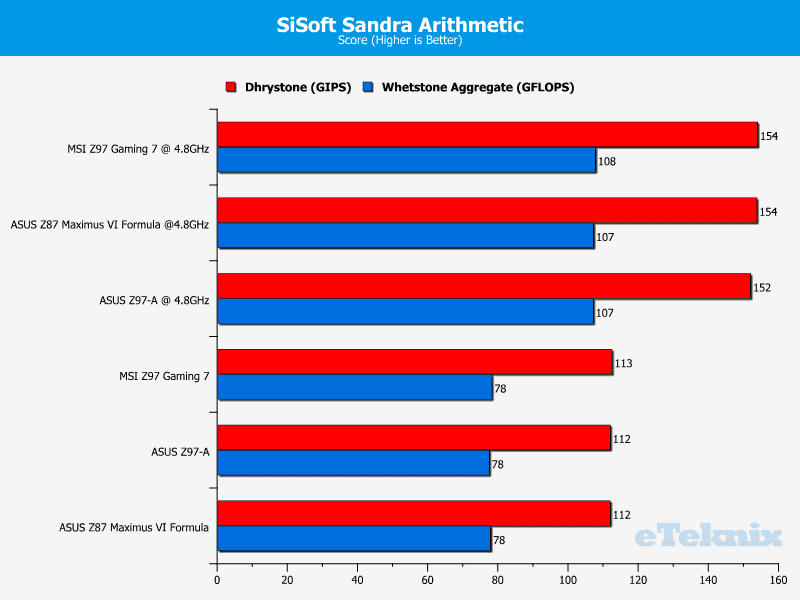
GPU Performance
3DMark
3DMark Firestrike is Futuremark’s latest creation for testing the GPU performance of high end gaming PCs using Direct X 11 graphics. You can download a free basic version of 3DMark here.
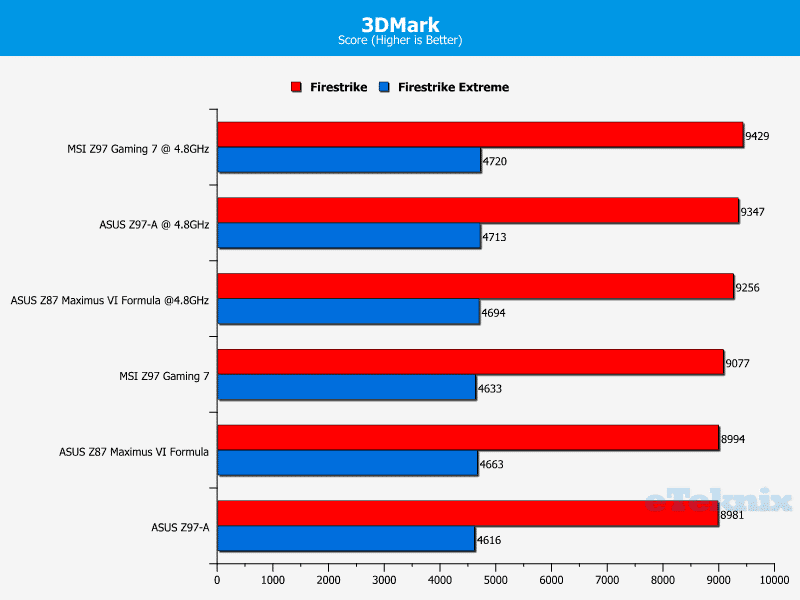
Tomb Raider
Tomb Raider is a popular action-adventure video game published by Square Enix based on the Tomb Raider franchise. The game was released in 2013 and as of March 2014 had sold 6 million copies.
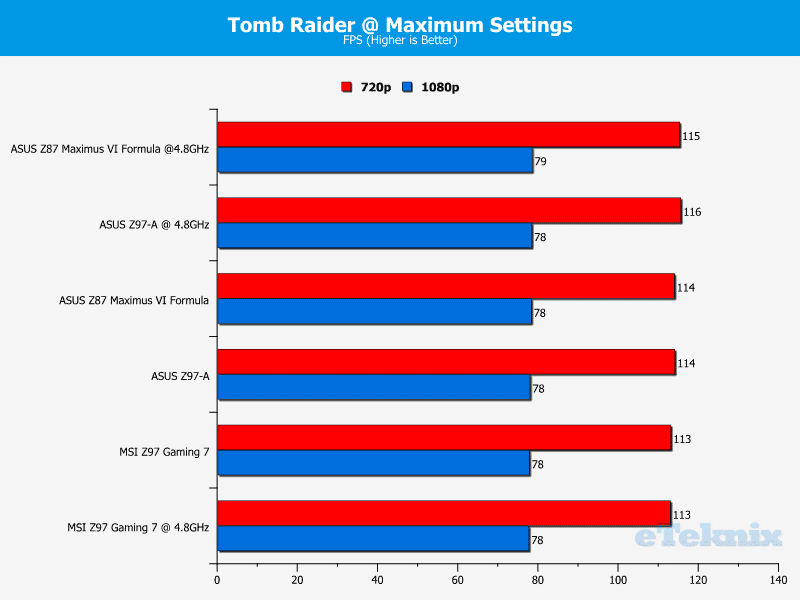
Bioshock Infinite
Bioshock Infinite is a first person shooter developed by Irrational Games that is the third instalment of the Bioshock series. The game is the last to be produced by Irrational Games before they announced their closure in February 2014. The game has sold over 4 million copies since its 2013 release.
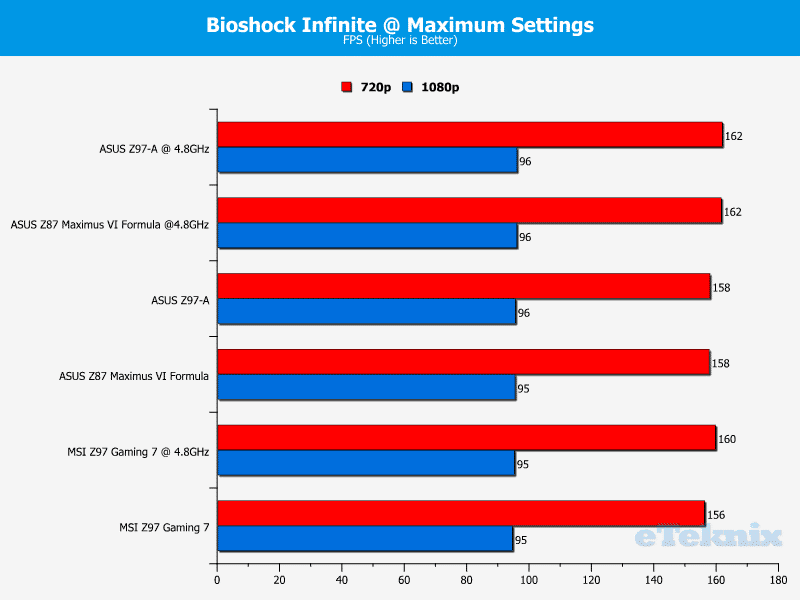
Memory Performance
For our memory tests we use the built in memory benchmarks in AIDA64 Engineer and SiSoft Sandra. For more details on each of the benchmarks please see here and here respectively.
AIDA64 Engineer
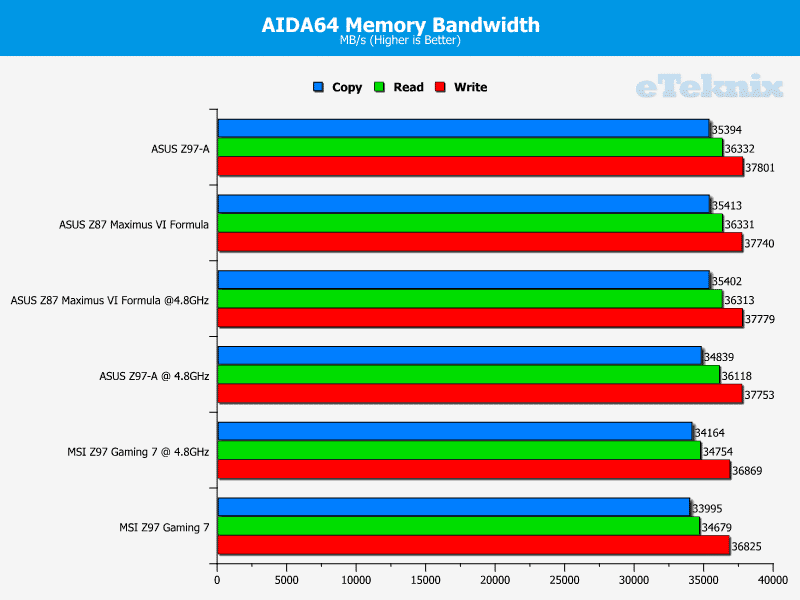
SiSoft Sandra
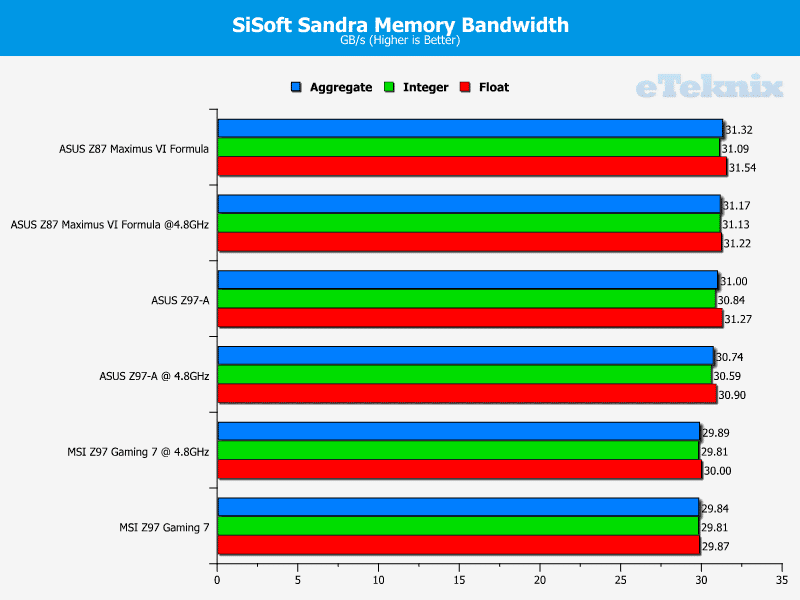
Combined Latency Test
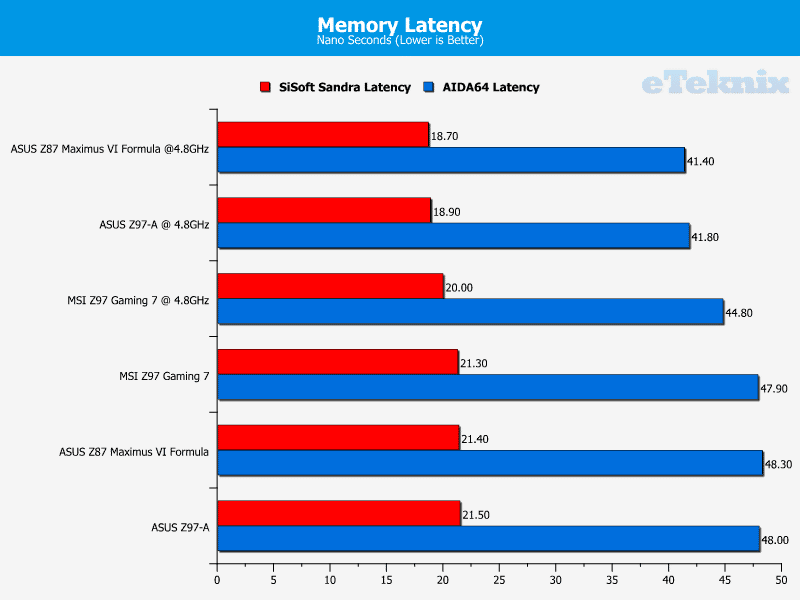
SATA, M.2 and USB Performance
To test the storage performance in our motherboard reviews we use AIDA’s Disk Benchmark utility built into their AIDA64 Engineer Edition software package and run a variety of read and write tests. We run each of the benchmark tests on a SATA III, USB 3.0 and M.2 device. For SATA III testing we use a Patriot WildFire 120GB SATA III SSD, for USB 3.0 testing we use the Kingston Hyper X 64 GB USB 3.0 flash drive and for M.2 testing we use Plextor’s 256GB M.2 M6e SSD. The drives are always formatted before use.
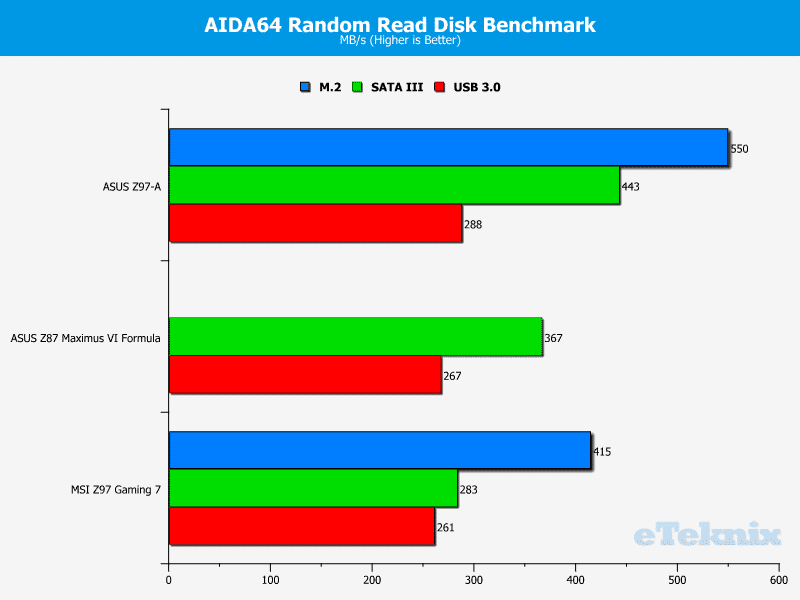
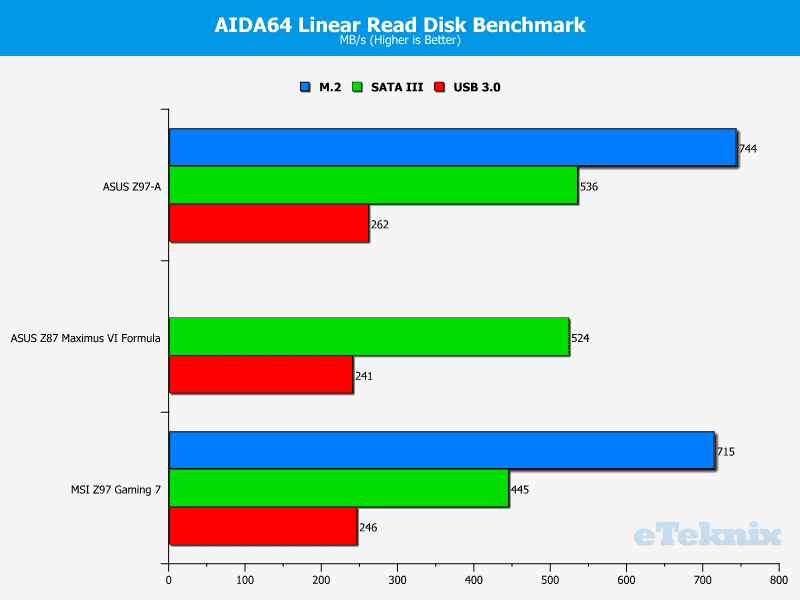
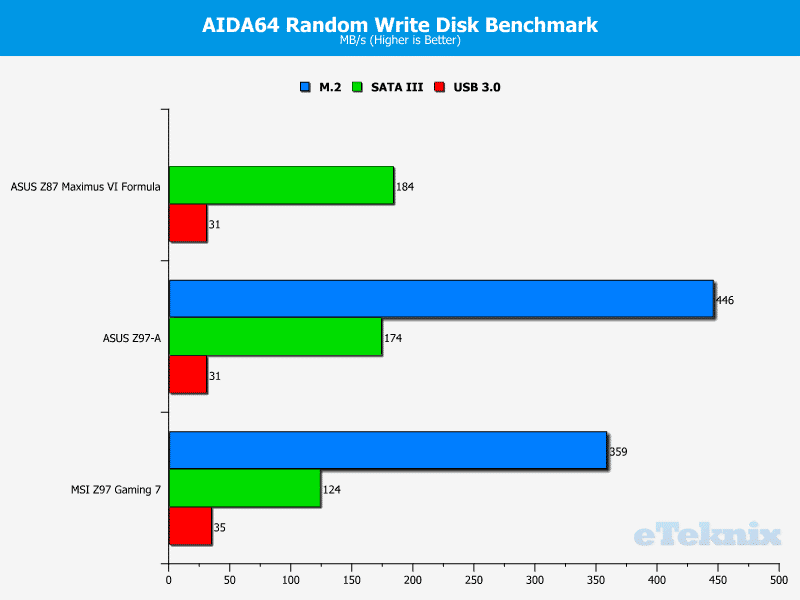
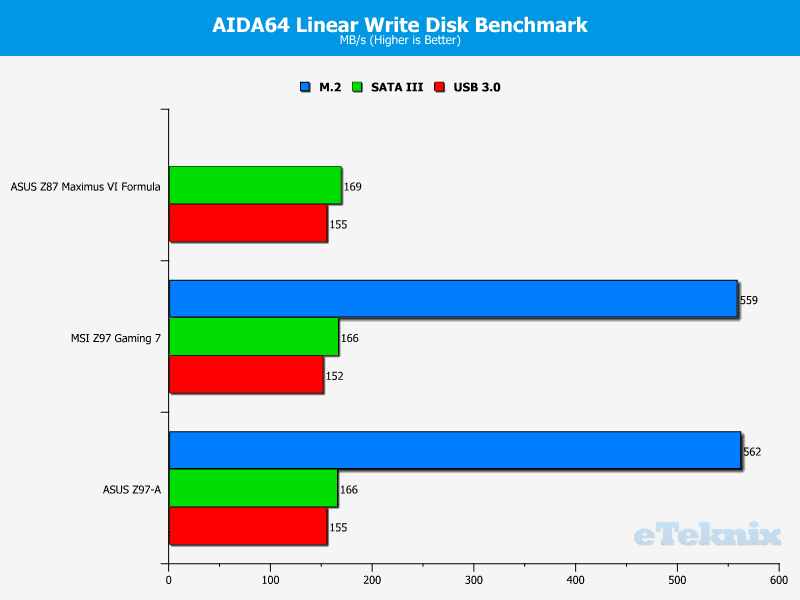
Networking Performance
For our networking tests we connect the test system up to our Intel Gigabit enabled ASUS Rampage IV Extreme X79 motherboard test system through the ASUS RT-AC68U router and run our tests. We opted for this over a direct point-to-point connection because we wanted to simulate real world performance.
LAN Speed Test Lite
LAN Speed Test was designed from the ground up to be a simple but powerful tool for measuring file transfer, hard drive, USB Drive, and Local Area Network (LAN) speeds (wired & wireless). It does this by building a file in memory, then transfers it both ways (without effects of windows file caching) while keeping track of the time. Download the free Lan Speed Test Lite utility from here.
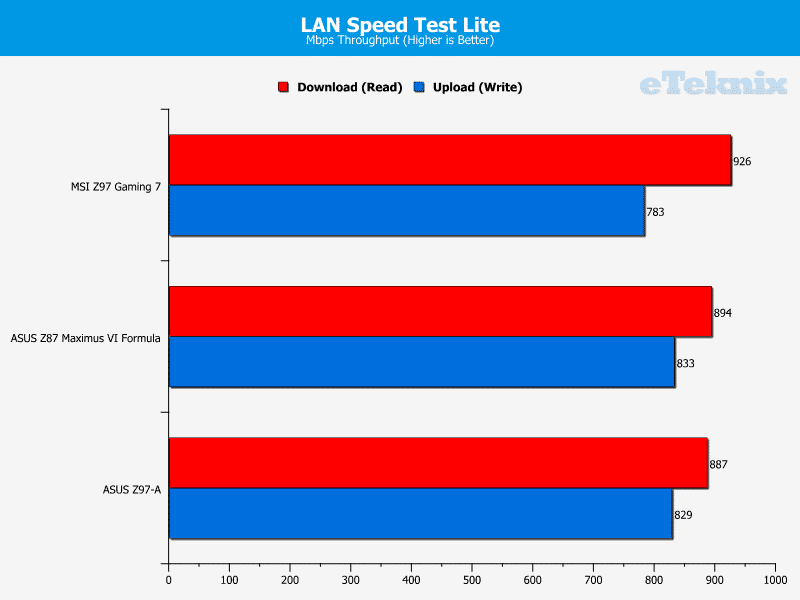
Passmark Performance Test 8
The PassMark Advanced Network Test (which is part of PerformanceTest) is designed to test the data transfer rate between two computers both of which must be running PerformanceTest. One of the computers must act as the server and will sit waiting for a connection. The other computer acts as a client. It connects to the server machine and sends data to it for the duration of the test. You can download a trial version of PerformanceTest from here.
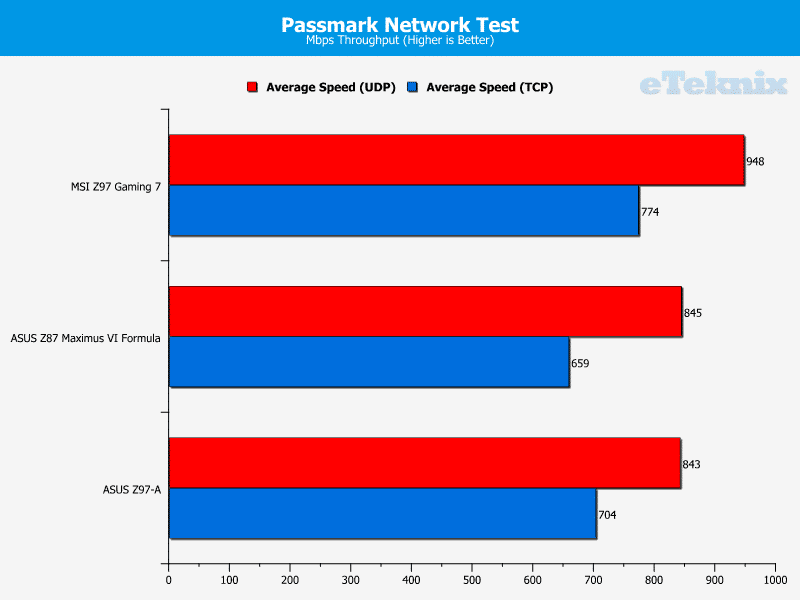
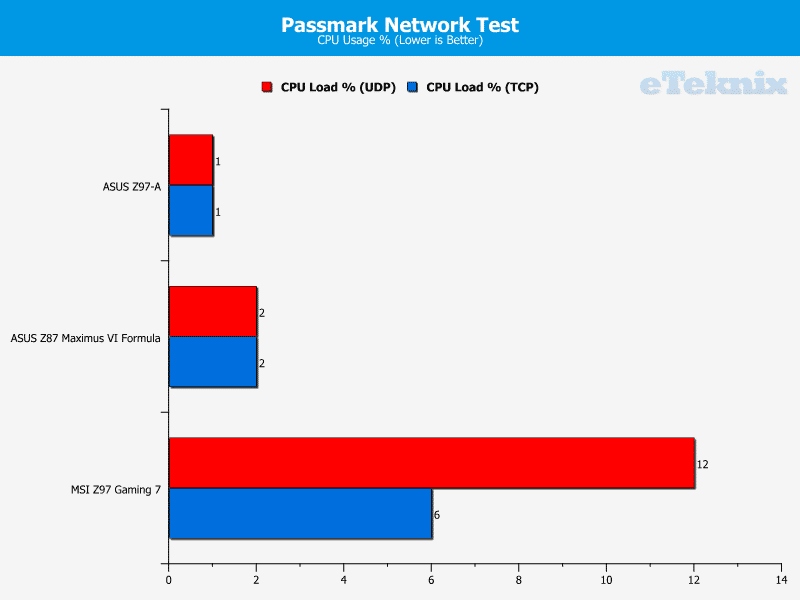
Audio Performance
RightMark Audio Analyser (RMAA)
RMAA suite is designed for testing quality of analog and digital paths of any audio device. The results are obtained by playing and recording test signals passed through the tested audio path by means of frequency analysis algorithms. A more common mark is also provided for those unfamiliar with measured technical parameters. Available here. We run the RMAA test using a 3.5mm to 3.5mm cable connecting the line out to the line in to test the quality of the motherboard audio codec not any external audio devices. We run the complete playback and recording test at default settings and then get RMAA to interpret the results giving the below outputs. We sync the playback and recording audio devices to the same setting as the test for accurate results.
16 Bit, 44KHz (DVD Quality)

16 Bit, 96KHz (Studio Quality)
16 Bit, 192KHz (Studio Quality)

DPC Latency Analyser
Thesycon’s DPC Latency Checker is a Windows tool that analyses the capabilities of a computer system to handle real-time data streams properly. It may help to find the cause for interruptions in real-time audio and video streams, also known as drop-outs. Available here.
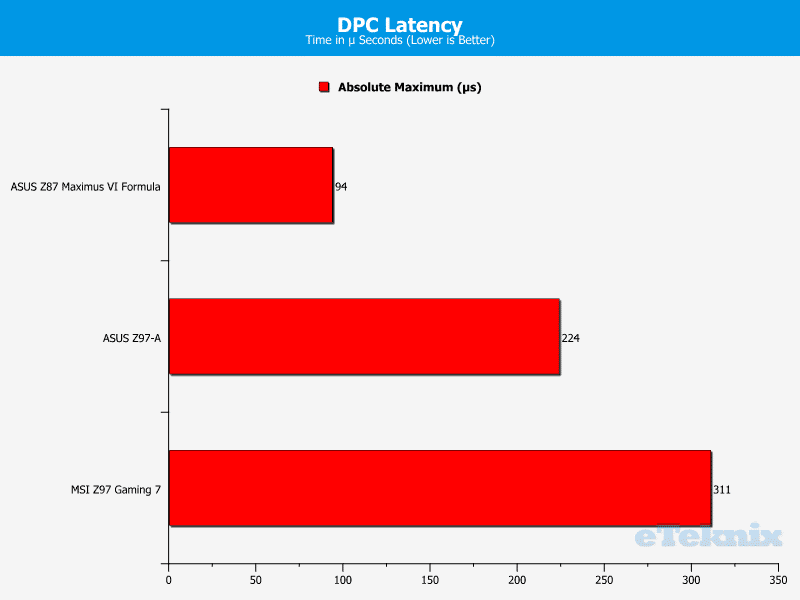
Power Consumption and Thermals
Power Consumption
To measure power consumption we use a killawatt meter and measure the total system power draw at the wall. We run three different use-case scenarios for 5 minutes and take the average reading.
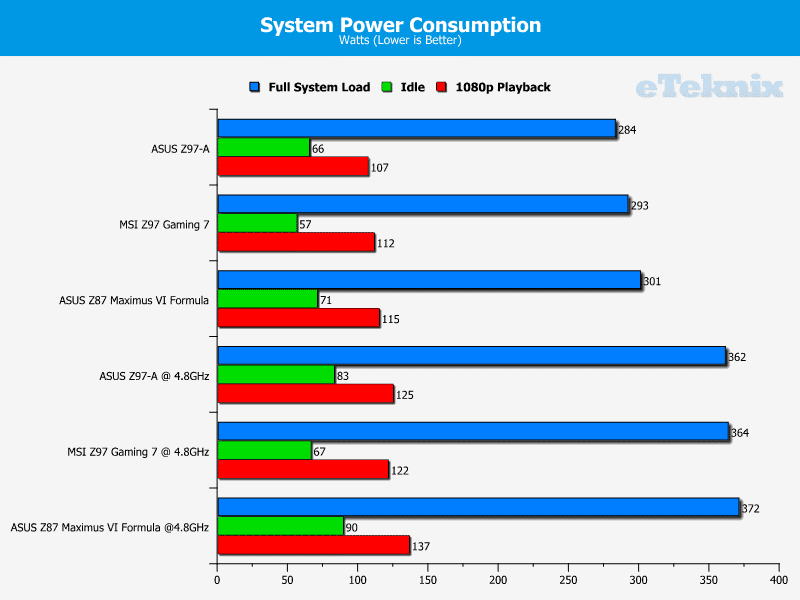
Thermal Performance
To measure the thermal properties of each motherboard we take the temperature of three different locations using a Rosewill infrared thermometer. We measure the hottest point on the PCH (chipset) heatsink, the first VRM heatsink (which is closest to the rear I/O) and the second VRM heatsink (which is closest to the RAM lanes).
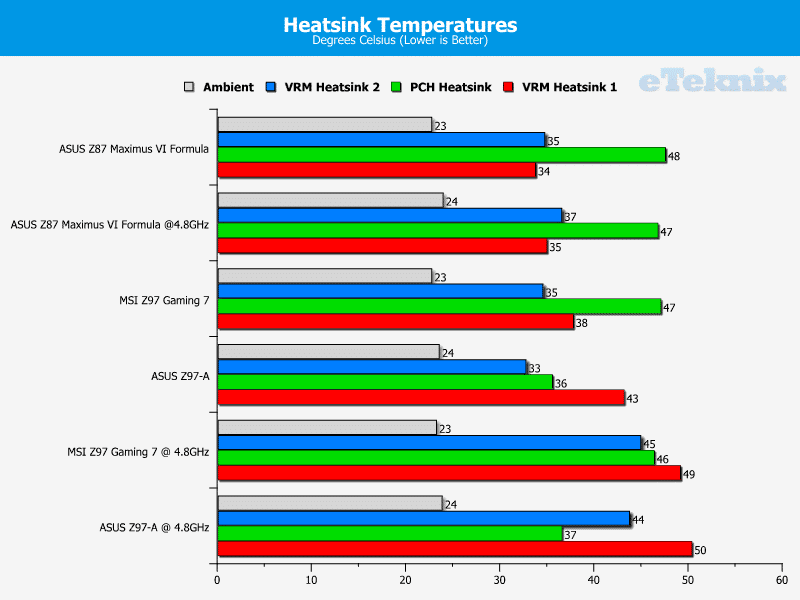
Final Thoughts
Pricing
MSI’s Z97 Gaming 7 motherboard is currently selling for $189.99 on Amazon and Newegg. In the UK the expected retail price is £139.99 from retailers like Amazon. The Z97 Gaming 7 motherboard from MSI comes with a 3 year warranty.
For UK readers reading this on launch day: don’t forget about MSI’s special launch day Z97 promotions of 20% cashback and free bundled Corsair cooling components!
Overview
The MSI Gaming Series brand has come a long way in a fairly short period of time. The MSI Z97 Gaming 7 represents an impressive achievement for MSI’s product design and development process. The product feels very well executed with sensible feature choices, attractive gaming aesthetics and a very compelling price point for what is a flagship gaming board. MSI have really managed to pin down the kind of features that a gamer wants and needs: packet prioritisation with a powerful network controller, high quality audio optimised for gaming headsets, support for multiple GPUs and overclocking for maximum gaming performance and most importantly a motherboard that fits the bill of what a gaming motherboard should look like. Whether you agree or not I still believe that aesthetics are one of the main driving forces in a motherboard purchasing decision, in this regard MSI have done extremely well. You only have to look at MSI’s P67/Z68 motherboards to see just how far they have come in terms of styling and catering to a gaming market they’ve never really gone after in the past.
I think there are a few areas for improvement though. Clearly our results show that MSI could do with a bit more optimisation on the storage side of things, maybe this can come through BIOS updates or some improved software utilities and drivers, performance seemed to be about 5-10% off where it should be based on my results with other motherboards. I also feel that the Killer NIC might not be the best choice for gamers – Intel’s NIC is equally as capable and has significantly less CPU overhead as well as offering much more compatibility with the native Intel Z97 platform. I can only assume that the Killer NIC is a more affordable solution which is acceptable and understandable given MSI’s success at keeping the cost of this product so low.
Pros
- Solid gamer aesthetics
- Great audio
- Rich extra features – debug LED, power/reset buttons, extra dip switches, voltage check points
- Very well priced
- Extensive accessory and software bundle
Cons
- Killer NIC has high CPU usage
- Second CPU fan header is awkwardly placed
- Below average storage performance
“MSI’s Z97 Gaming 7 motherboard is something MSI should be proud of. For the price I am amazed at not only how much MSI have managed to cram in, but also how well they have managed to execute it. Intel’s Z97 launch has hardly been well executed or inspiring but boards like this one from MSI have certainly made it worth the wait.”
Thank you to MSI for providing this review sample.




















